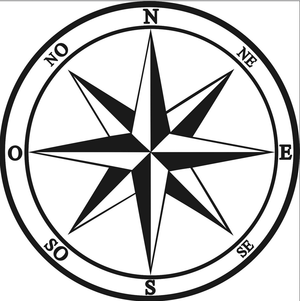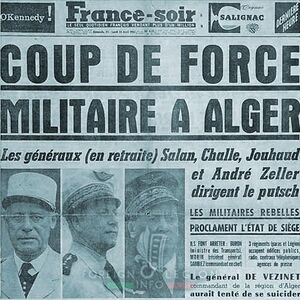France/Stay behind
(Stay Behind) | |
|---|---|
 A wind rose, the name of the French stay behind | |
| Formation | 1947 |
| Parent organization | |
| Interests | |
| NATO's stay behind which were involved in several assassinations and coup attempts against President de Gaulle | |
The French Stay behind network, known as the Rose des vents (meaning wind/compass rose, not coincidentally the same image as the NATO symbol) has a dramatic history. Formally designed as a anti-communist guerilla organization, it meddled more and more in internal politics, participating in de Gaulle's coup in 1958, then in a coup attempt against de Gaulle in 1961 and several assassination attempts he narrowly escaped.
To counter this, de Gaulle built his own loyal service, the Service d'Action Civique, plus evicting NATO from France in 1966, accusing the CIA of manipulating the West and being involved in covert warfare.[1]
Contents
Background
The first national elections took place in October 1945. Due to the enormous 'street cred' of the communists during the resistance, the communist party won the elections. With 26% for the Communists and 24% for the Socialists, the left-wing camp formed a large majority, compared to only 23% for the right-wing camp in the capacity of the Popular Republican Movement. Charles de Gaulle had promised the communists important ministerial posts, but he did not keep his word. The protest was so fierce that de Gaulle was eventually forced to resign in January 1946. A logical step now was to divide the ministerial posts among the communists and socialists, but strangely enough, the latter refused. The Communist Party feared that such a government would lead to a coup. The Soviet Union, preferring stability in post-war Europe, had told them that could not count on Soviet support. In addition France would not be able to enjoy the Marshall Plan funds, which the country desperately needed.[2]
New elections were called in November 1946, but again, the communists came out victorious, this time with 29 %, their highest result ever. The United States was now very alarmed and decided to eliminate with all its might the communist party. At the initiative of both the US and the British Special Air Service (SAS), a series of armed networks were installed in France, whose mission was to prevent the CP from taking power, by any means necessary. This "secret army" was codenamed Plan Bleu, and attempted a coup in 1947.
SDECE
- Full article: SDECE
- Full article: SDECE
In 1949, the US embassy cabled the State department in Washington:
To fight the danger of communism, France has organised cells of restrained but efficient policemen. Also Italy is erecting such anti-communist police squads under the control of Interior Minister Mario Scelba, using commandos of the former fascist police.[2]
After some reorganization, a reliable anti-communist secret service, the Service de Documentation Extérieure et de Contre-Espionnage (SDECE), was established[2]. From 1947, the SDECE continued to work in complete secrecy on the development of a new clandestine anti-communist army, this time under the code name Rose des vents.
In fact, when NATO was founded in 1949, with its headquarters in Paris, the SDECE would conduct its secret anti-communist war in close collaboration with that military alliance. In addition, from 1951, secret cooperation with the US was intensified when the SDECE opened an office in Washington.
The “Rose des vents” received similar orders as stay behind in other countries: evacuation preparations, equipped with a suitable exile base abroad, training for sabotage, guerrilla and espionage. Training took place in different parts of France, such as the Pyrenees, as well as beyond, and always in close collaboration with the French special armed forces. Particularly noteworthy was the involvement of the extremely highly trained French paratroopers command, the 11th Demi-Brigade Parachutiste du Choc, or 11e du Choc for short. Their relationship with the secret army was intense and several officers of the 11th du Choc were also members of the Rose des vents. Just as the British SAS acted as the unit to do the dirty jobs for MI6, the 11th du Choc was the iron fist of the SDECE. One of the most prominent members of the 11th du Choc was Yves Guérin-Serac.
It might have been involved in Bob Denard's assasination attempt on Prime Minister Pierre Mendès-France in 1954.[citation needed]
The 1958 de Gaulle coup
- Full article: French 5th Republic
- Full article: French 5th Republic
Since the Second World War the 11th du Choc has mainly operated in Indochina and Africa, where France unsuccessfully tried to keep its respective colonies of Vietnam and Algeria. It was precisely because of the combination of colonial interests with those of the secret anti-communist struggle that the French stay-behind derailed.
When Algeria's struggle for independence erupted in full force from 1958, the government initially did not know how to respond. The French Secret Service and the Army on the other hand, were insistent: the French colony had to be preserved at all costs and the fight against the Algerian liberation front FNL had to be intensified. When the first French prisoners were murdered by the FNL, the French secret service and the army staged a coup in France. The 11th du Choc played a crucial role in this process, albeit on two widely separated levels. Some of the secret soldiers wanted to bring Charles de Gaulle back to power with the coup d'état. Another part opposed this. However, de Gaulle's daring coup was a success, and in May 1958 he took over the government and installed the 5th Republic.
Attempting to kill de Gaulle
- Full article: Organisation armée secrète
- Full article: Organisation armée secrète
However, the forces who supported de Gaulle in 1958 did not get what they had expected. They believed De Gaulle would support the colonial policy of a French Algeria, but he decided just the opposite and gave the final green light for Algerian independence. In 1962 the country actually gained that independence. The 5th Republic was therefore treated with great suspicion by the gladio-members. After an initial hesitation, it finally came to a final break in the 11th du Choc. In 1961 most members opted for a continued French Algeria and founded the clandestine and illegal Organisation Armée Secrète (OAS) in Algeria.
What the OAS coup advocated was twofold: the preservation of the French colony and thus the continuation of the struggle against the FLN, and the overthrow of the 5th Republic and its president Charles de Gaulle, replacing them with a militant anti-communist authoritarian French state.
The OAS coup came on April 22, 1961 when four French generals under General Maurice Challe seized power in Algeria. The coup also allegedly involved the CIA, the Pentagon and the NATO stay-behind. One of the reasons for that assumption lies in the fact that General Challe was NATO Commander in Chief Allied Forces Central Europe and in that capacity had close ties to the Pentagon as well as several US officers and the secret US-led stay-behind army.[3]
Furthermore, a May 1961 article in L'Express by Claude Krief revealed that 10 days before the coup, namely on April 12, 1961, a secret meeting had taken place in Madrid where several foreign agents including members of the CIA and the Algerian conspirators had gathered. came and discussed the plan for a coup. During the meeting, the Americans also complained that de Gaulle's policies paralyzed NATO's work and threatened European security. They allegedly assured the putsch generals that if their plan succeeded, Washington would recognize the new Algerian government within 48 hours.[4]
When de Gaulle withdrew the French army from NATO's militarily integrated command in 1966, some secret agreements between the US and France were also abolished. So on that occasion it was revealed that secret protocols with with regard to the fight against communist subversion did exist and were signed bilaterally by the US and its NATO allies. But de Gaulle denounced those protocols as an infringement of national sovereignty.
Service d'Action Civique
- Full article: Service d'Action Civique
- Full article: Service d'Action Civique
After siding against de Gaulle and losing, the Rose de vents were reformed, but not abolished. Training still took place in Cercottes near Orléans and the members were recruited from, among others, the SDECE and the 11e du Choc. At the revelation of Gladio in 1990, the training camp in Cercottes was identified as one of the centers of secret warfare where French gladiators received training.[5]
References
- ↑ Douglas Porch, The French Secret Services, p. 409
- ↑ Jump up to: a b c Daniele Ganser, NATO’s secret armies, pages 84-86.
- ↑ Jonathan Kwitny, The CIA’s Secret Armies in Europe: An International Story, in: The Nation, 6. April, 1992, pages 446-447
- ↑ quoted in William Blum, Killing Hope: VS Military and CIA interventions since World War II, page 149
- ↑ Jacques Baud Encyclopédie du renseignement et des Services Secrets, Paris 1997, page 546.
